We selected highlights from the SOFIA processed data archive, from a variety of programs which are available to be analyzed by anyone in the astronomy community. You can find help on how to analyze SOFIA processed data in these tutorials .
| Highlight | Image | Summary |
|---|---|---|
| AGN-Related Datasets |
To obtain one of the datasets listed below, go to the SOFIA Archive , open the "Proposal Constraints” tab, and enter the corresponding Plan ID (PID). |
|
| Using ISM Structure to Constrain the Origin of Anomalous Microwave Emission |
![(left) The GREAT [CII] map of RCW175 with contours from the WISE3 11.3 micron map overlaid. (right): The [CII] spectra for one of the pixels at the edge of the HII Region.](/data/SOFIA/docs/sites/default/files/styles/lightboxgallery_height_500/public/2022-08/RCW175.png)
|
Understanding the structures present in the interstellar medium is an important step for determining how energy and material flow through our galaxy. The [CII] emission line is an ideal tool for studying structure, as carbon has a relatively low ionization potential, and therefore traces the interface between the ionized gas and the atomic gas. Spectrally resolved maps of the [CII] emission across the Perseus Molecular Cloud and the HII region RCW175 created by the GREAT instrument provide detailed information about the structure and kinematics of the gas in these two regions. |
| Characterizing the dust and PAH of the ultracompact HII regions |
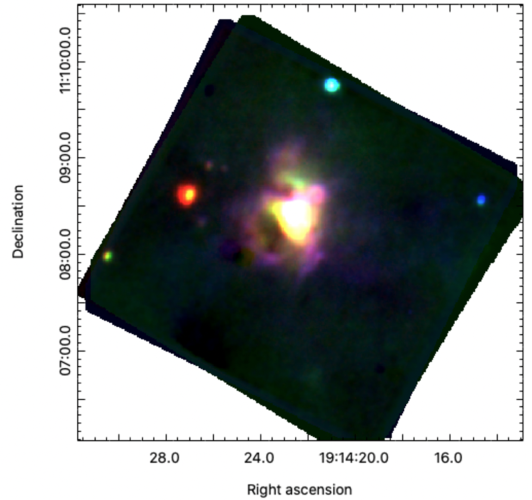
|
Compact HII regions allow us to investigate the early phase of the interaction between the young massive stars and their environment. Polycyclic aromatic hydrocarbon (PAH) molecules and dust play an important role in the evolution of the properties of the HII regions. |
| The hot dust distribution in galactic regions of stellar feedback |
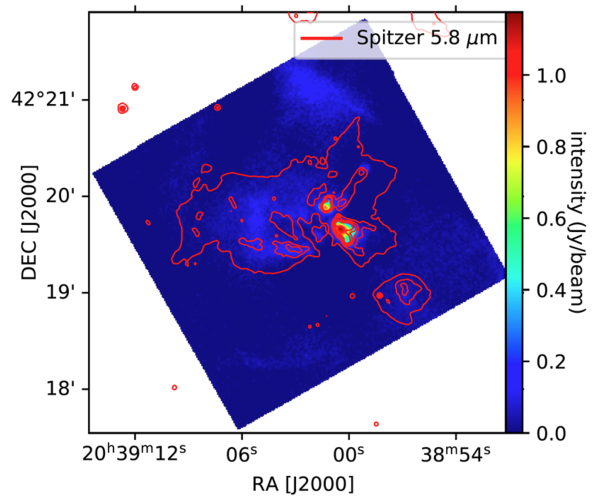
|
When high-mass stars are formed in the densest regions of molecular clouds they start heating and dispersing the cloud. The disruption of clouds by stellar feedback plays a central role in galaxy evolution and the associated dust heating results in dust emission in the mid-infrared that affects the spectral energy distribution (SED) of observed galaxies. Directly observing and resolving this heated dust in galactic HII regions is thus important to understand the impact of stellar feedback and how it shapes galactic SEDs. |
| Jets and outflow in protostellar cores of Orion |

|
The Orion molecular clouds (OMCs) is the most active star forming region in the solar vicinity and thus an ideal target to study individual low- to intermediate mass star forming cores. Observations carried out with the GREAT receiver on the SOFIA telescope detected the [OI] line at 63 μm and the CO(16-15) line towards four protostars in the OMCs. |
| Legacy Program: Magnetic Fields in Nearby Galaxies |
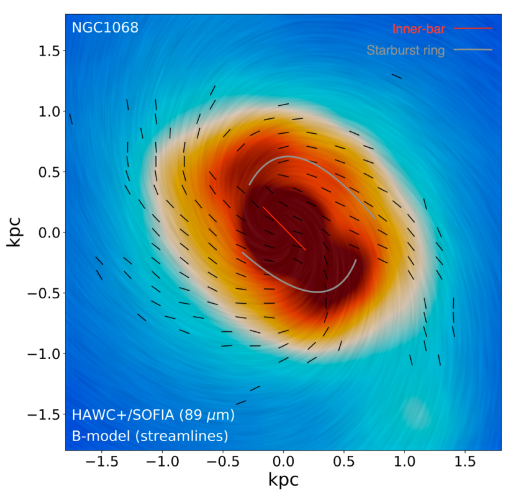
|
What is the role of magnetic fields in sculpting the ISM at kiloparsec scales? This question is the driver behind the Legacy Program 'SOFIA heralds a new era of measuring the magnetic fields of galaxies' , led by Enrique Lopez Rodriguez (KIPAC/Stanford) and Ann Sui Mao (MPIfR). This survey consists of 50-220 microns polarimetric observations of a flux-limited sample of 17 nearby galaxies including starbursts, mergers, active galaxies, and spiral galaxies. |
| A Testbed for Starburst Activity: 30 Doradus |

|
30 Doradus (the Tarantula nebula) is a very wide HII region which hosts strong starburst activity. At its center lies a large cluster of massive stars, which powers extended PDR regions. Thanks to its location in the LMC, it is one of the best laboratories to study how local conditions -- thermal, kinematic, density and magnetic fields -- support starburst activity. |
| The Multi-phase Envelope of NGC 7538 IRS1 |
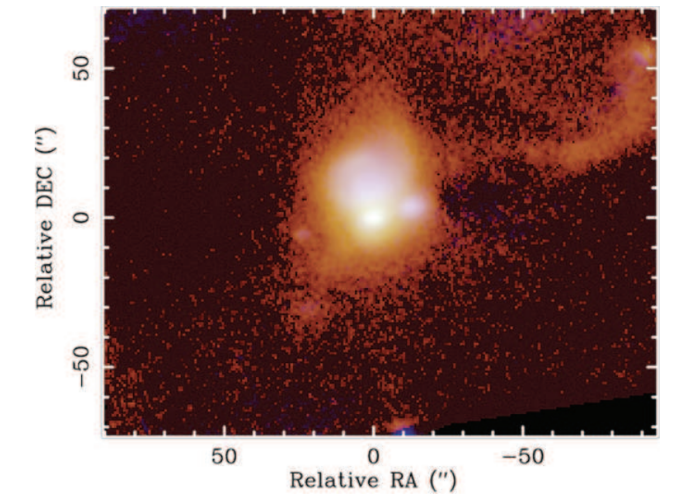
|
NGC 7538 IRS 1 is one of the many IR-bright, young stellar objects (YSO) within the HII region NGC 7538, in the Perseus’ arm of the Milky Way. IRS 1 is still actively accreting mass, offering one of the best perspectives into the very first stages of star formation. The composition of the protostar’s envelope can be used to retrace the early processing of gas, dust and PAHs by the UV radiation field, which should be strongly absorbed during this young phase. SOFIA extensively observed IRS 1 in the mid and far-IR, providing: |
| Exploring the CMZ: the Arches Cluster |
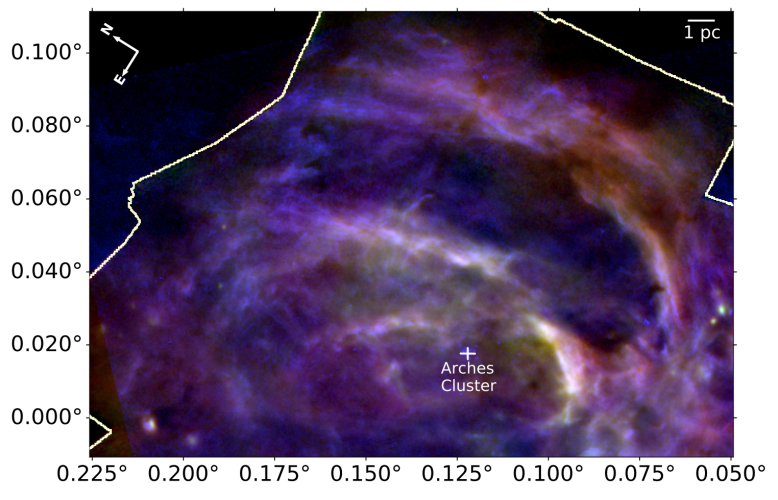
|
The Arches Cluster, the densest star cluster in our galaxy, is located within the Galactic Center’s Central Molecular Zone (CMZ), just about 25 pc from Sagittarius A*. Named after the arch-shaped radio-bright structures in its line of sight, it is believed to be an important ionization source, powering the major star formation area in the CMZ (the Galactic Center bubble). |
| New [C II] Maps in Massive Star Formation Regions |
![SOFIA/upGREAT map of line integrated [C II] emission in RCW120 SOFIA/upGREAT map of line integrated [C II] emission in RCW120](/data/SOFIA/docs/sites/default/files/styles/lightboxgallery_height_500/public/Other/Images_Media/RCW120.png)
|
Massive stars strongly influence the chemistry, dynamics, morphology and thermal structure of their natal environment through a variety of processes globally described as stellar feedback. Feedback is significantly altering these environments, affecting star formation in them, and eventually regulating the evolution of galaxies. |
| Organic Inventories in Young Stellar Objects and Disks with EXES |
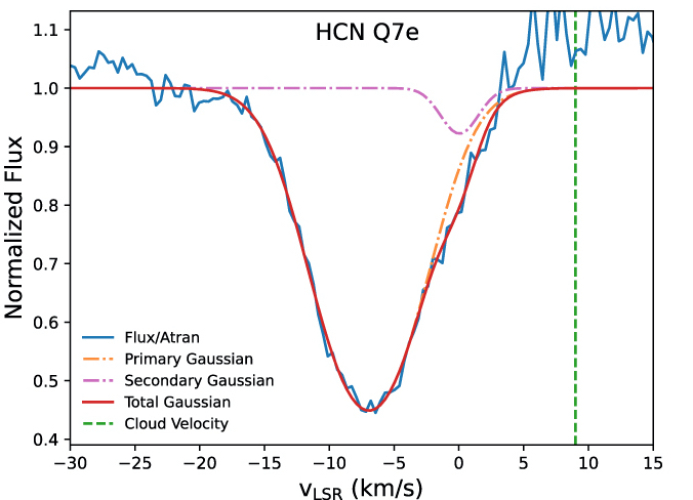
|
The 5.5-8 microns spectral region is rich in vibrational and rovibrational transitions of organic molecules and their isotopologues, including pre-biotic molecules. Spectral signatures from water (in particular the ground state v2 vibrational band), formaldehyde, methane, ammonia, CH3, HCN, and more complex organics can be emitted from warm and hot regions around young stellar objects, as well as the inner regions (<a few AU) of protoplanetary disks. |
| Orion Molecular Cloud (OMC-1) |
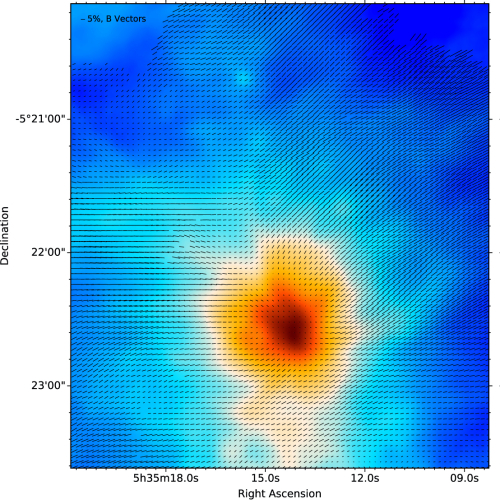
|
Combined analysis of mid- and far-IR spectroscopic and photometric data is key to the study of the chemistry, kinetics and thermal structure of star forming regions, probing warm dust as well as ionized and molecular gas. One of the nearest massive star forming regions, OMC-1, is situated just behind the Orion Nebula and has been extensively observed with all SOFIA instruments. |
| Betelgeuse High Resolution 25 Micron Spectra 2015-2020 |
![The spectral orders near the [S I] 25.25 µm line The spectral orders near the [S I] 25.25 µm line](/data/SOFIA/docs/sites/default/files/styles/lightboxgallery_height_500/public/Other/Images_Media/thumb8_ExesBetel.jpeg)
|
An observing program was executed close to the Betelgeuse's V-band minimum in February 2020 under several Director's Discretionary Time (DDT) programs. These observations obtained with the EXES instrument were focused on high-spectral resolution spectra around 25 microns, encompassing forbidden [Fe II], [S I] and two water absorption features. Similar data were already obtained in 2015 and 2017, allowing evaluations of variations in line flux and width over time, with sufficient resolution (R~50000) to identify gas velocity changes. |
| Galactic Center Legacy Program |
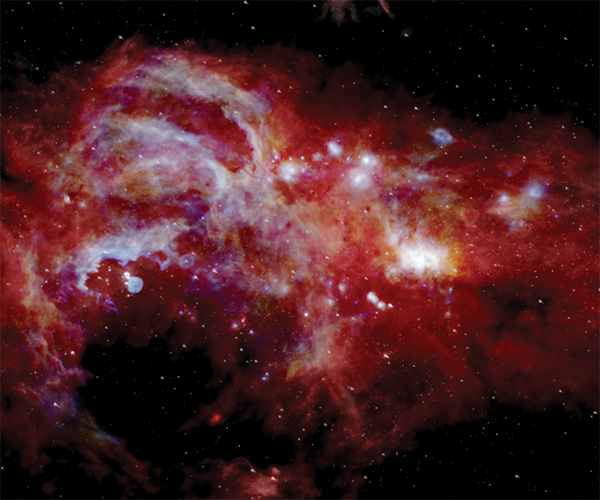
|
The inaugural Legacy Program used the FORCAST instrument to observe the Galactic Center using the 25-micron and 37-micron bands. The data have unprecedented spatial resolution – six times higher than past observations — resulting in a vastly improved view of warm dust in the center of the galaxy and revealing signatures of star formation in exquisite detail. |
| [OI] and CO Maps of Pillars in the Carina Nebula |
![GREAT maps of G287P77 in [OI] GREAT maps of G287P77 in [OI]](/data/SOFIA/docs/sites/default/files/styles/lightboxgallery_height_500/public/Other/Images_Media/thumb10_GREAT_maps_G287P77.png)
|
The Carina Nebula is home to several massive star clusters and more than 65 O stars. The Trumpler 16 cluster, including its famous member eta Carina, is thought to power the winds and radiation responsible for carving out the complex structures seen in Figure 1. Based on the morphology of these structures, this region of the Carina Nebula known as the South Pillars. Because these pillars are likely formed by the strong winds and radiation of massive stars, they are ideal places to investigate the interaction between this stellar feedback and dense molecular gas. |
| [C II] Map of the M51 Galaxy |
![SOFIA [C II] Map of M51](/data/SOFIA/docs/sites/default/files/styles/lightboxgallery_height_500/public/Other/Images_Media/M51.png)
|
The entire galaxy M51 was imaged using both FIFI-LS and GREAT. The FIFI-LS observations took only 7 hr of observatory (wall-clock) time. The image is shown with a surface brightness scale in units of erg/s/cm2/sr.
“
A SOFIA Survey of [C II] in the Galaxy M51. I. [C II] as a Tracer of Star Formation
”
|
| S-DDT Highlight: 30 Doradus Maps using HAWC+ |
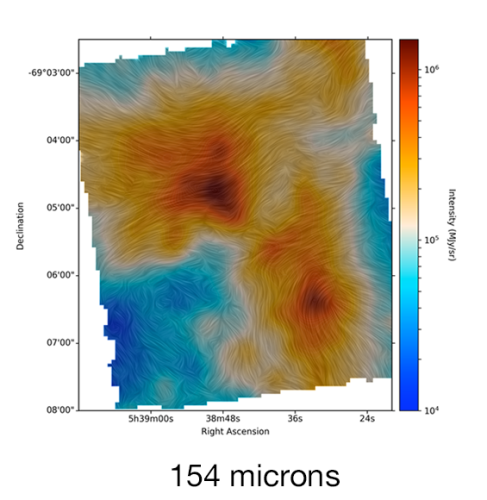
|
"
SOFIA Community Science I: HAWC+ Polarimetry of 30 Doradus
"
|
| DDT Highlight: Horsehead Nebula Velocity Resolved [C II] Map using GREAT |
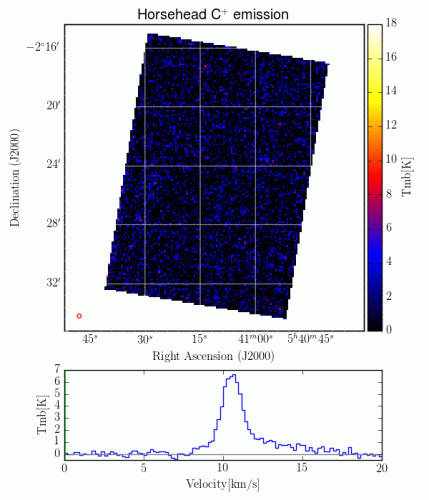
|
Velocity resolved map of the Horsehead Nebula—a dark nebula and photodissociation region in the Orion Molecular Cloud Complex—using GREAT . The map was taken in the [C II] line at 158 μm. Read more here . |
| DDT Highlight: SN 2014J Imaging and Spectroscopy with FORCAST, FLITECAM, and HIPO |
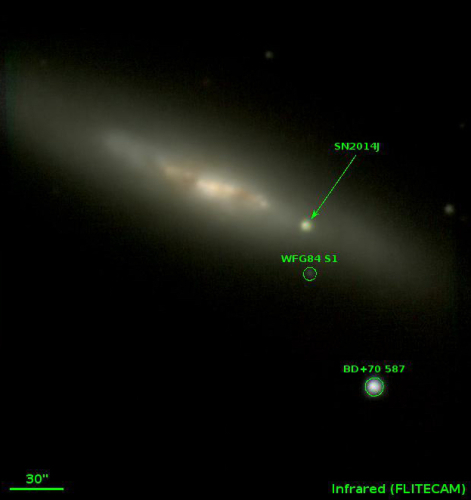
|
Imaging and grism spectroscopic data to probe the ejecta and surroundings of the bright Type Ia Supernova, SN 2014J, in M82. The observations were taken using FORCAST and the now retired instruments FLITECAM and HIPO . Read more here . |
| Velocity Resolved [CII] and [NII] Maps of Select HII Regions of M33 |
![[CII] maps of HII region NGC604 in M33 [CII] maps of HII region NGC604 in M33](/data/SOFIA/docs/sites/default/files/styles/lightboxgallery_height_500/public/Other/Images_Media/M33-thumb.png)
|
Understanding the processes of star formation is one of the major goals of extragalactic astronomy. One important piece of this goal is determining how the energy inputted into the interstellar medium (ISM) by young stars is regulated and eventually dissipated through emission of far-infrared cooling lines. Measurements of cooling lines can also provide insight on the potential feedback processes that could be enhancing or limiting star formation. |
| Proplyds of Orion seen with [OI] and OH |
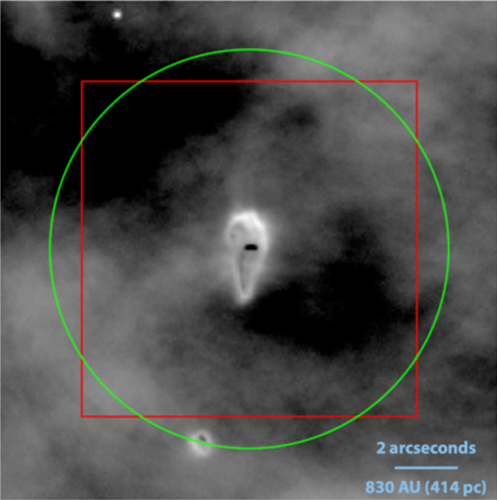
|
SOFIA observations with the GREAT receiver provide spectrally resolved (~0.2 km/s) observations of [OI] at 63 μm and OH at 163 μm, towards three proplyds in Orion: HST 10, 244-440 and the Beehive. These three proplyds in Orion have also been observed with Herschel covering multiple lines: [CII], several high-J CO lines and spectrally unresolved [OI] emission ( Champion et al. 2017 ). |
| CO Excitation across the Circumnuclear Disk |
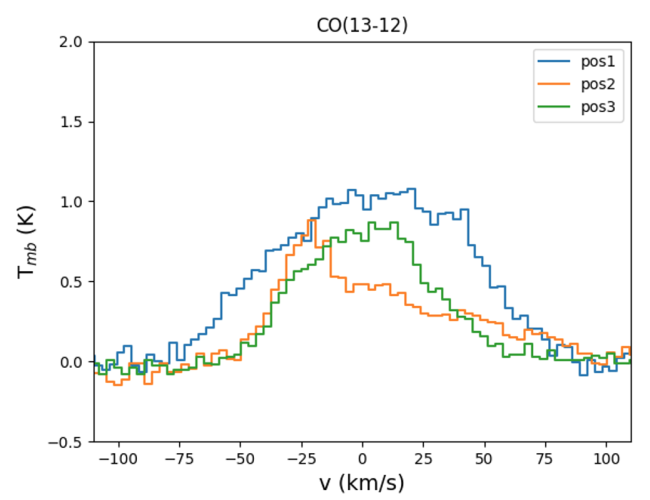
|
The Milky Way Galactic center (GC) is the only laboratory in which we can spatially resolve the gas components and separate the physical processes that take place in galactic centers. The molecular gas of the GC is distributed in a torus structure, the circumnuclear disk (CND). A complete sample of CO J-transitions, from low-J transitions (e.g. J=2-1) to the high-J transition accessible only with GREAT (e.g. J=16-15), allows for the separation of different gas components, and for the identification and analysis of the physical properties and excitation processes present in the CND. |
| The Impact of a Supernova Remnant on a Molecular Cloud |
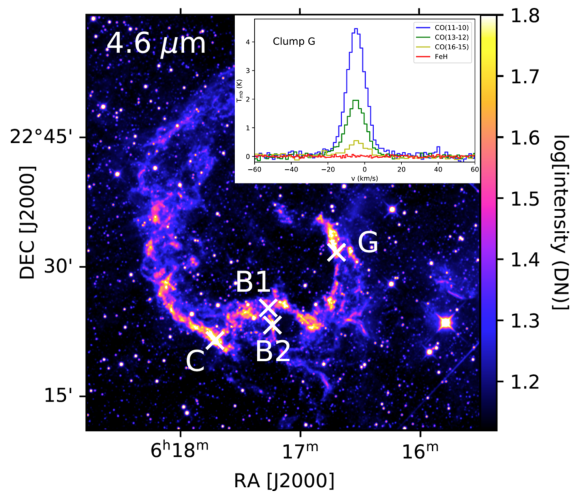
|
The SOFIA data of IC 443 can be found in the IRSA SOFIA Archive , and consist of: |
| [CII] line emission towards a sample of galaxies |
![[CII] integrated intensity image of NGC 5908, observed with FIFI-LS, overlaid with contours of CO emission observed with CARMA](/data/SOFIA/docs/sites/default/files/styles/lightboxgallery_height_500/public/2022-08/76_0007tn.png)
|
[CII] is the main coolant over a wide density range in the interstellar medium. As a result it is expected that the total [CII] emission is correlated to the local star formation activity which was confirmed for a relatively large sample of galaxies. However, starburst galaxies show a lower [CII] emission than expected. It is thus important to understand the relation of [CII] emission with the SFR, cooling, extinction and molecular gas. |